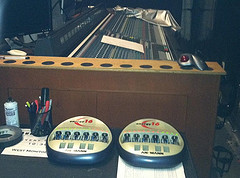
Getting Recharged
A fair amount of people have asked about rechargeable batteries on Twitter so I figured I should do a post on it.
For those who don’t know, I switched our AA batteries from Duracell ProCells to rechargeable batteries a couple months ago. I feel like there momentum has built behind production use of rechargeable batteries over the last couple years, so it seemed like it was worth investigating the option. I did some testing for a couple months and arrived at a lot of the same conclusions as my friend Mike Sessler. You can find results of the testing he did over on his blog.
I settled on the Ansmann 2850 AA batteries with the Ansmann Energy 16 chargers. These are the batteries Mike is using and also the brand Cirque Du Soleil and the Blue Man Group shows are using. A lot of other church techs also vouched for these so going into testing they were the strongest option.
Here are a few reasons for the switch:
The sporadic nature of events has made it very difficult to manage inventory for my two stages. It takes time to check stock and reorder, and I was still running out of batteries when we should have had plenty. It just seemed like there are better things I could be doing with my time than making sure we’re not running out of batteries.
With the rechargeables, I’ve found that this has become vastly simplified. Since the chargers are out where I can see them, it’s easy to see if I’m missing batteries while working backstage and in our amp room because there is a light for every battery on the charger. If I see a light that’s out, I’m missing a battery, although that hasn’t really been an issue now that our crews are in the habit of keeping the batteries on the chargers at all times.
We were going through a ton of AA batteries since our RF in-ears and microphones all use AA’s. We ALWAYS replace batteries on the day of a service or event because we’ve all been burned too many times by batteries that didn’t last quite as long as we thought they would.
When I ran numbers on purchasing the chargers and enough Ansmann AA’s to fill every device we could operate simultaneously plus a few spares, it looked like I would recoup my investment in just over four months based on our alkaline battery spending trends. The bulk of that cost is the chargers, and I figured in the future I can replace my entire stock of AA’s for about the cost of a 2-3 month supply of alkaline AA’s, and my current plan is to do that every year assuming that we don’t run into any major issues with these batteries within our first year of use.
Now, I do want to say that the money side of this isn’t as simple as what I said above. It’s honestly very hard to calculate the actual savings. Physical inventory costs are greatly reduced, but there are still ongoing costs of using rechargeable batteries because the electricity coming out of the wall that charges them isn’t free. However, I do feel we are much less wasteful with the rechargeables because we were always discarding partially used alkalines. A higher percentage of our costs go directly to the energy we use now instead of putting part of it in a landfill or staff and volunteer’s TV remotes. There are probably also cost savings on the labor side, too, since I don’t spend nearly the same amount of time managing batteries that I used to.
The Ansmann AA’s consistently outperformed the alkalines. I can honestly say that after using them for a few months, I feel more confident having an Ansmann in a mic than an alkaline. We used to have batteries die during long rehearsals all the time since we were often running on leftovers from Sunday, but that hasn’t happened since we changed over since we pull the batteries off the charger at the start of rehearsal now.
Now I have a few more comments on this whole thing. If you’re interested in rechargeable batteries, I strongly suggest you do some testing of your own for a couple of key reasons. For starters, you need to make sure the batteries will physically fit in your gear. Rechargeable batteries tend to be slightly larger in physical size than alkalines so not all brands will fit in all pieces of gear. I tried another one of the brands that Mike tested, but didn’t like the way it fit in our gear. As it stands, the Ansmanns I settled on fit, but they are tight.
Secondly, you need to make sure you can establish a system with your volunteers and/or staff to make sure that the batteries live on a charger when not in use. If you can’t get people to buy into putting batteries in and taking them out every time gear gets used, switching will be a waste. These batteries I’m using do not have a shelf life; they need to live on a charger when not in use. If you’re in a portable situation, this might not be a good option for you.
It’s also important for you to get a feel for how these batteries discharge. The NiMH rechargeable batteries we’re using do not discharge in a linear fashion like an alkaline will. The rechargeables typically drop a bar on the mic battery meter pretty fast, but then they will hold on 3 or 4 out of 5 bars for 9 hours or longer. When they go down from there, they tend to drop pretty fast. This can be unnerving if you’re not prepared, but we were when we started testing and avoided any issues from this.
In regards to other battery sizes, I am still using alkalines for AAA’s and 9 volts because the rechargeable versions just don’t have the same capacity. For example, our Ansmann AA’s are rated for 2850 mAh, but a 9v is rated for 250. I have six hardwired IEMs that use 9v’s and a max of 2 bodypacks on AAA’s a week. In contrast, I could potentially have 38 or more devices on our stages using AA’s; it’d be rare, but the capacity is there. Keeping our AAA and 9v gear running on alkalines is not a big deal for us especially now that I don’t have to worry about all the AA’s.
If you are serious about investigating rechargeable batteries, you should go read Mike’s posts on his blog–he actually had a pretty lengthy series on batteries. He’s been using these for a long time and also has some great data and information on use along with pretty charts.
Finally, if you do decide rechargeables are the way to go, do yourself a favor and invest in professional rechargeable batteries. You’re probably not going to find what you need at Loews, Home Depot, Best Buy, or Radio Shack. Mike mentions some other brands and models on his blog, and I’d suggest you start with those. You can also talk to the folks at Horizon Batteries because they were a big help in getting us setup.
If you have any questions I haven’t answered, please leave them in the comments.


 Previous Post
Previous Post Next Post
Next Post


